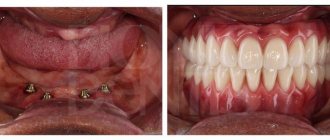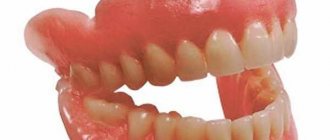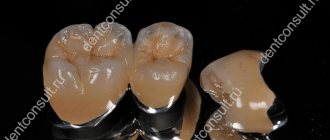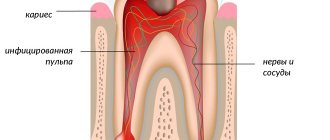- Introduction
- Causes of tooth loss
- Causes of tooth enamel loss
- Partial and complete tooth decay
- Consequences of tooth loss
- The impact of tooth loss on the body as a whole
- Tooth-preserving operations
- Diagnostics before dental restoration
- Main stages of diagnosis
- Dental restoration methods: advantages and disadvantages
- Methods for restoring tooth roots with dentures
- Features of dental restoration in children
- How to choose a teeth restoration method
- Dental prosthetics
- Is it worth saving damaged teeth?
- Restoration cost
Causes of tooth enamel loss
Tooth enamel protects the tooth from external factors and is the hardest, but at the same time, fragile tooth tissue. Reasons why enamel loss or destruction occurs:
- Injuries, blows.
- Bad habits: smoking or drinking alcohol.
- Excessive consumption of sweets.
- Drinking very hot or very cold drinks.
- Malocclusion.
- Fruit acids in natural juices can be acidic and erode enamel.
- Failure to comply with hygiene rules.
- Gastritis, hypertension and diseases of the endocrine system entail a decrease in the enamel layer.
- Chemical exposure to harmful substances, for example, taking medications, carbonated drinks.
- Lack of fluoride and calcium in food.
- Bruxism.
- Incorrectly chosen dental hygiene products.
Partial and complete tooth decay
As a result of loss of enamel, teeth are partially or completely destroyed. The depth of the lesion shows how far the inflammatory process has gone. Depending on this, treatment is selected. Diseases leading to partial and complete tooth destruction:
- Caries.
- Pulpitis.
- Periodontitis.
- Periostitis.
- Pericoronitis.
- Osteomyelitis
- Acute limited osteomyelitis.
- Acute diffuse osteomyelitis.
- Chronic odontogenic osteomyelitis.
- Periodontal disease.
The above problems are subject to therapeutic treatment. Some illnesses take time to heal. The doctor will do everything possible to save the tooth. But in an advanced stage, these diseases are the main causes of tooth loss leading to the need for prosthetics.
Dental diseases: causes, prevention and treatment
Dental disease is best prevented. Lack of proper oral care is not always the only cause of dental and gum disease. Poor environment, poor quality food, chronic diseases, heredity also lead to dental disease.
Tartar is formed from dental plaque. The reasons are irregular or improper oral care, the use of low-quality toothbrushes and toothpastes. Plaque forms if chewing is done on one side of the jaw or the person has a metabolic disorder.
Symptoms of tartar:
- itchy gums;
- bleeding gums;
- bad breath.
- Upon examination, dark spots are noticeable near the gums.
Tartar not removed in time leads to gingivitis, periodontitis and tooth loss. For prevention, it is recommended to brush your teeth properly, carefully removing plaque, and also use high-quality toothpastes and brushes.
Treatment of tartar comes down to its removal with special instruments. It is very important to eliminate the cause of the disease, such as malocclusion. At the dentalcanada.ru clinic this is achieved through neuromuscular dentistry.
Caries is the most common dental disease. This is a complex and sluggish process of destruction of all tooth tissues. The main cause of caries is fermentation processes on the surface of the tooth. There are 4 stages of caries, but only at the last stage, with visible disturbances, do patients consult a doctor. An experienced dentist will see any stage of the disease: clouding, discoloration, and timely treatment will save the tooth.
Prevention of caries is identical to prevention of plaque. You should also reduce your sugar intake and use mouthwash at least 3 times a day after meals. It is important to eliminate foci of caries development: to fill diseased teeth. The Canadian Center for Innovative Dentistry and Neuromuscular Therapy suggests sealing irregularities in teeth, since any cavities serve as a breeding ground for bacteria. Practice shows that such measures reduce the likelihood of disease by 90%.
Pulpitis is a complication of caries. If the disease is not advanced, there is a chance that the nerve endings will be preserved. If the disease has developed into a purulent or chronic process, the doctor performs a procedure called “nerve removal” (depulpation) and filling the canal. It is important that the channels are sealed hermetically, compactly and tightly. In our clinic, for these purposes, we use the method of three-dimensional canal obturation, which is currently the most progressive.
Untimely, improper treatment of the dental canal system can lead to another disease: periodontitis.
Periodontitis is an inflammatory process in which the tooth becomes loose, the gums and adjacent part of the cheek become inflamed, accompanied by unbearable pain with a possible increase in temperature.
Treatment of periodontitis is complex and is always carried out in several stages. It is especially difficult to treat the disease if the canals have already been sealed. The dentist will have to unfill the canal, which is not always possible due to the density of the material. At the Canadian Center for Innovative Dentistry and Neuromuscular Therapy, the doctor will deal with this problem using a laser.
Periodontitis is an inflammation of the gums that support the tooth, with a violation of the integrity of the periodontal junction. The causes may be various diseases (diabetes mellitus) and injuries due to malocclusion, hypertonicity of the masticatory muscles.
Prevention of periodontitis - careful oral care, proper nutrition and timely dental treatment. At our clinic, specialists diagnose this disease at an early stage. Treatment may be medication or surgery.
Gingivitis is an inflammation of the gums that does not lead to tooth loss. Without treatment, the disease can develop into periodontitis. Treatment boils down to professional cleaning of the oral cavity; in severe cases, antibiotics are prescribed.
An annual dental examination will help identify major dental problems at an early stage, and timely treatment will make it possible to remain with a radiant smile for a long time.
Consequences of tooth loss
Tooth loss does not go unnoticed for the human body as a whole and for various organs in particular. Even such a small organ as a tooth is of great importance in the human body, so it is important to take care of your health before the onset of illness.
For bone structures
the consequences of tooth loss are a shift in load - neighboring teeth can change their position in the mouth, the antagonist tooth does not receive the load and its root is exposed. Over time, the alveolar bone decreases in height and width. Over the course of a year, height loss is up to 4 mm. With complete edentia, the bone decreases even faster.
For soft tissues, tooth loss leads to a decrease in volume, the formation of bedsores, and discomfort. If prosthetics are not performed, the tongue will increase in size. At the same time, the tongue performs a useful function: it helps the denture to chew and limits its actions.
Aesthetic consequences of tooth loss
become more obvious with age. If the patient does not wear prosthetics, the face will look older than its age ahead of time. The height of the face decreases, the bite is disrupted, the chin begins to protrude, the corners of the lips droop, which is why the face looks sad. The nasolabial fold increases, the lip line becomes thinner. The tone of the facial muscles decreases and a double chin appears.
Psychological consequences
different depending on the patient's condition. There are patients who ignore tooth loss and continue to live as they lived before. For patients with a labile nervous system, the situation is more complicated and may lead to the development of a neurotic state. Losing a tooth and changing the appearance of the oral cavity negatively affects the patient’s mood and thinking.
The loss of a tooth and prosthetics, especially if they are removable dentures (“teeth in a glass”), are perceived as the onset of old age. Many skills that used to come naturally now become stepping stones to overcome. Patients need to relearn how to chew and speak.
Many people are very upset by diction defects when, due to dentures, it is not possible to pronounce certain sounds as clearly as before wearing dentures. The patient cannot eat all the foods he used to love. The fear of losing a prosthesis in public while socializing or eating together may prompt the patient not to leave the house and limit his social circle.
We recommend meeting with a psychologist who will help you cope with new circumstances, discover the potential of your body and organism, and not lose enthusiasm in training aimed at comfortable use of dentures.
Reasons for deletion
Caries
destroyer of teeth, very often leads to their removal. It is important when caries appears , to take all measures to get rid of it. After all, severely damaged teeth cannot be restored and therefore they are removed. In addition, caries, as a rule, does not stop on one tooth, but spreads to the rest.
But besides terrible caries, there are other reasons for tooth extraction, which are also very common.
Tooth infections
Infections are often the reason why the dentist is forced to resort to radical methods. After all, the infection is very dangerous as it spreads throughout the oral cavity and, if left untreated, can lead to damage to many teeth. And then you will have to say goodbye to more than one tooth.
Cyst
An example of such an infection is a dental cyst. This is the body's protective reaction to the appearance of bacteria. The cyst is a kind of capsule and is characterized by its appearance on the root of the tooth, has the property of rapid growth and is initially completely invisible to the host. A tooth cyst can destroy its healthy tissue, which leads to subsequent removal.
Another equally dangerous infection is periodontitis . In addition to tooth loss, this infection can also cause an increase in sugar in the body. This happens in cases where the problem is not addressed. Periodontitis is an inflammation that rises from the gums to all tooth tissues and causes damage that leads to loosening of the tooth in its cell.
Very often in his work, a dentist encounters a wisdom tooth. Its removal is very important, because many people have problems with the appearance of a wisdom tooth. This is its incorrect location, and changes in the bite, and because of this, elementary pain appears, which is impossible to endure, and not worth it.
Removing tooth fragments also often falls to the dentist. Splinters that may remain as a result of injury or improper treatment are often the cause of inflammatory processes.
It is important to know that tooth extraction surgery is not possible for pregnant women. Therefore, it is worth thinking about the health of your teeth before you decide to have a child.
The impact of tooth loss on the body as a whole
Loss of teeth
- a serious loss for the entire human body as a whole. Don't underestimate the loss of even one tooth. Changes in bones lead to changes in facial features, making a person look older. Difficulty in communication and speech defects in the pronunciation of certain sounds impose certain restrictions. Losing teeth and wearing removable dentures worsen the quality of life, nutrition, and problems with the gastrointestinal tract arise due to changes in the usual diet. We recommend that you do not delay your consultation with a prosthetist dentist, who will tell you what type of prosthetics is right for you.
Methods for restoring tooth roots with dentures
The tooth root can be restored if the source of infection is stopped and the root walls are 1-2 mm, there is reason to preserve the tooth root. The root is assessed with prospects for prosthetics. The root will serve as the basis for placing the pin. If necessary, the root canals are expanded, and therapeutic treatment is carried out aimed at preparing a place for the anchor pin. The pin is suitable for use if there is no complete destruction of the tooth crown.
Another method for restoring tooth roots
serves as a stump tab. It is installed in the tooth canal, strengthening it. The inlay is called a stump inlay, since one part of it has the shape of a tooth stump, on which the tooth crown is then installed. The inlay is more reliable than a pin, it is easily replaced, can correct the bite, strengthens the tooth, and, thanks to the even distribution of the load, prevents tooth decay.
Features of care after removal
The actual process of tooth extraction is only halfway to dental health. It is very important to behave correctly after visiting the dentist. There are several rules:
- You should not eat immediately after removal (2-3 hours);
- You should not rinse your mouth with any medicinal products without a doctor’s prescription;
- You are allowed to brush your teeth only the next day;
- It is not recommended to touch the wound with your tongue or other objects, as well as chew on the side on which the diseased tooth was located and eat hot foods.
There are many reasons for tooth extraction. Therefore, if you experience any pain or discomfort in your mouth, you should immediately contact your dentist. After all, it can be either harmless inflammation or terrible infections or caries. The process of extraction, as well as dental treatment, is now absolutely not scary and painless. Don't be afraid, because it might be worse later. Needless to say, the cost of tooth extraction is completely justified.
Features of dental restoration in children
Children's milk teeth need restoration.
Previously, milk teeth with a large area of carious lesions were preferred to be removed. Today, dentists have come to the conclusion that preserving baby teeth in a child’s mouth until they are physiologically replaced is very important for the development and proper functioning of the jaws.
It is important that the child’s chewing function is not impaired due to the premature loss of baby teeth. If a tooth is missing or incorrectly positioned, the development of a correct bite is disrupted. Missing teeth negatively affects diction, which can also cause psychological problems. The purpose of preserving baby teeth is to ensure proper eruption of permanent teeth.
Increased load on other teeth
In the absence of any teeth, their function is taken over by neighboring teeth, and accordingly, the load on tooth enamel, crowns and roots increases significantly. This leads to the fact that teeth begin to deteriorate many times faster. For example, when removing molars, the incisors have to take on a task not provided for by nature - grinding food. As a result, longitudinal and transverse cracks appear on the enamel, the edges of the teeth wear off and turn yellow.
Increased load over time turns out to be fatal for the roots, as it provokes their increased mobility. If you do not reduce the constant pressure, bone tissue will also begin to suffer from overload.
How to choose a teeth restoration method
Modern methods of dental restoration
are diverse and it is quite difficult for the patient to navigate medical terms on his own in order to assess for himself the advantage of a particular method. On our portal we provide comprehensive information on methods of dental restoration. You will find the addresses of trusted clinics and the names of doctors with a reliable reputation and extensive experience.
By studying possible ways to restore teeth before visiting a doctor, you will be prepared for a substantive conversation with the dentist. To choose the method that is most suitable for your particular case, it is most necessary to consult with your doctor. He will assess the condition of the tooth requiring intervention and select a treatment option. By agreement with the patient, the doctor begins work. In dental treatment, important aspects are the professionalism of the doctor, the quality of materials and the trust of the patient.
Is it worth saving damaged teeth?
Dentistry today has many tools in its arsenal to restore damaged teeth. To answer the question: does it make sense to save a decayed tooth, you need to consider several factors:
- Condition of the tooth and its root, bone tissue, canal.
- The cost of restoring a damaged tooth is lower than the cost of an implant or fixed denture.
- A natural tooth is better than any artificial tooth. If a tooth, root, canal can be cured, then the restored tooth will last for a very long time.
- The option of microprosthetics using Glasspan technology will allow for gentle intervention and achieve excellent results.
- The patient decides for himself whether to save the tooth or not, but the dentist will explain to him the prospects of this or that decision.
Complete absence of teeth
The cheapest solution when all teeth are missing is to have removable dentures made. They are made from nylon, silicone and acrylic; modern dentistry uses them widely. In the fight against the numerous disadvantages that such prostheses have, experts prefer to use fixed prosthetics, using implants as support. There is also a technique of conditionally removable prosthetics, which is something between plate-type prosthetics and full-fledged permanent implantation.
If teeth are missing for a long time, this can cause unpleasant consequences. In addition to deteriorating the quality of life and deprivation of external attractiveness, harm is caused to the entire human body. But if your teeth are lost, do not rush to give up on yourself. Using the achievements of modern dentistry, you can restore any number of teeth, from one to all at once. The main thing is to contact an experienced specialist in time, undergo professional diagnostics, choose the right method of prosthetics and begin treatment immediately.
Restoration cost
The cost of restoring a damaged tooth is important for the patient, since different tooth restoration techniques differ in price. The price will depend on the number of manipulations required to treat and restore the tooth, on the chosen technique and material. Only a doctor can tell the full cost after an examination and selection of materials together with the patient. For example, a doctor’s consultation starts from 500 rubles and above, a stump inlay from 6,500 rubles and above. The cost of services varies depending on the clinic. Convenient navigation on the portal will allow you to see different prices in different clinics.











